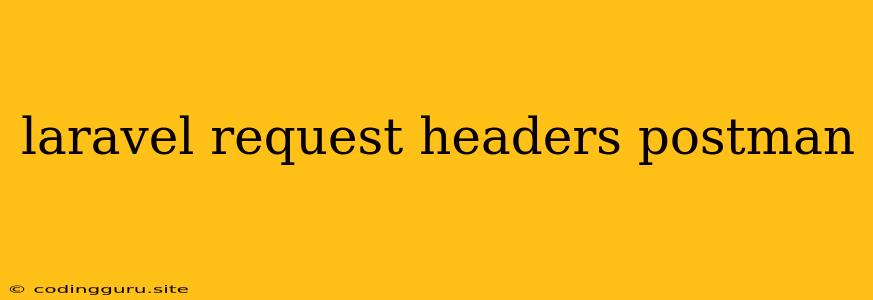Sending Requests with Headers in Laravel using Postman
Laravel, a popular PHP framework, provides powerful tools for handling HTTP requests and responses. When working with your Laravel applications, you often need to send specific information in the request headers. This could be for authentication, API key validation, or various other purposes.
Postman, a popular API testing tool, is a fantastic way to send requests and manipulate headers. It allows you to easily craft complex requests and view the response, making it ideal for testing your Laravel endpoints.
Why Use Headers in Laravel?
- Authentication: Headers can be used to send authentication tokens (e.g., JWT) for user authorization.
- API Key Validation: For securing your API, headers can carry API keys to verify requests.
- Content Type: Specifying the content type of the data being sent (e.g., JSON, XML, form-data).
- Custom Headers: You can create custom headers for specific application logic.
How to Send Headers with Postman
-
Open Postman: Launch the Postman application.
-
Create a New Request: Click on the "New" button to create a new request.
-
Select HTTP Method: Choose the HTTP method you want to use (GET, POST, PUT, DELETE, etc.).
-
Enter URL: Input the URL of your Laravel endpoint.
-
Add Headers:
- Click the "Headers" tab in the request builder.
- Click on the "Add" button to create a new header.
- Enter the Key (the header name) and the Value (the header value).
- For example, to send an API key header named "Authorization", you might enter:
- Key: Authorization
- Value: Bearer your_api_key
-
Send the Request: Click the "Send" button.
Working with Headers in Laravel Controllers
In your Laravel controllers, you can access the request headers using the request object. For instance:
use Illuminate\Http\Request;
class MyController extends Controller
{
public function index(Request $request)
{
// Get the value of the 'Authorization' header
$apiKey = $request->header('Authorization');
// Check if the API key is valid
if ($apiKey === 'your_secret_api_key') {
// Process the request
// ...
} else {
// Return an error response
// ...
}
}
}
Example Scenarios
Scenario 1: Authentication with JWT
- Postman Request:
- Headers:
- Authorization: Bearer your_jwt_token
- Headers:
- Laravel Controller:
- Use the
Authfacade to verify the JWT token and authenticate the user.
- Use the
Scenario 2: API Key Validation
- Postman Request:
- Headers:
- X-API-KEY: your_api_key
- Headers:
- Laravel Controller:
- Extract the API key from the
X-API-KEYheader and compare it to your stored key.
- Extract the API key from the
Tips and Best Practices
- Standard Headers: Use standard header names (e.g.,
Authorization,Content-Type,User-Agent) whenever possible. - Case Sensitivity: Headers are case-sensitive.
- Secure Headers: Consider using HTTPS to protect sensitive information sent in headers.
- Documentation: Document your API's expected headers for developers.
Conclusion
Sending headers with Postman and utilizing them in your Laravel applications offers a powerful way to enhance your API security, authorization, and data transfer. By understanding the purpose of headers and using them effectively, you can build robust and secure Laravel APIs.
